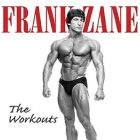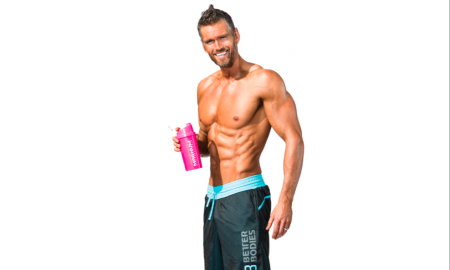 Scott Abel’s recent book, The Abel Approach—Program Design and Coaching Strategies for the New Era, is a unique and controversial contribution to muscle building. Its 284 pages are packed with useful new information. In Part 2 of this exploration of Scott and his theories we’ll discuss his major contributions to training, including innervation training, hybrid training and metabolic-enhancement training.
Scott Abel’s recent book, The Abel Approach—Program Design and Coaching Strategies for the New Era, is a unique and controversial contribution to muscle building. Its 284 pages are packed with useful new information. In Part 2 of this exploration of Scott and his theories we’ll discuss his major contributions to training, including innervation training, hybrid training and metabolic-enhancement training.
First a word of warning: Abel’s ideas may seem to run contrary to commonsense bodybuilding. Well, as Albert Einstein once said, “Common sense is the collection of prejudices acquired by age 18.” The proof of their effectiveness can be found at Abel’s Web site. Click on “Testimonials” to see the results achieved by the men and women he coaches. His work is challenging simply because it’s outside deeply ingrained opinion, yet it’s supported by state-of-the-art science. What’s more, his ideas are similar to those on which much of contemporary sports coaching, amateur and professional, is based.
Innervation Training
Abel has developed not one but three methods of training. They all work well, leaving the choice of which to use up to you. The key to all three is intensity. For Abel the basic ingredient of success is learning to tap into the degree of intensity common to world-class amateur and professional athletes. Think of it as “progressive-intensity training” rather than progressive resistance—meaning that intensity is far more important than the amount of weight you lift. In other words, strength and intensity are not necessarily the same thing.
When Abel talks about strength, he suggests about a half dozen different types of strength. Regardless of which kind of strength you might be working, he said, you “win the workout” by exercising with the utmost intensity.
What makes intensity progressive? The word intensity came into our training vocabulary nearly 40 years ago with Arthur Jones’ seminal articles published in Iron Man. Since then Jones’ ideas have remained pretty much unmodified:
Then as now, “intensity of effort” meant training a set “to momentary failure.” Hence, intensity was typecast as a one-shot hit-or-miss deal. Jones understood intensity as connected to strength. Once strength was exhausted, you couldn’t move the barbell again, so the set was over. For Jones and his followers, intensity and muscular strength were inseparable. Abel introduced the idea that you could develop intensity progressively while not going to failure.
Much of Abel’s training insights come from neuromuscular research. As a champion bodybuilder, he recognizes that intensity is not a property of muscles but of the central nervous system—the mind/muscle connection. Simply put, intensity is an adaptive process learned by the nervous system, which includes the mind and central nervous system. As such, intensity is a learned response to training in which the nervous system optimizes control of muscles in exercises.
Innervation training also stresses a mental orientation in which the poundage on the barbell is not as important as the intensity you summon and maintain. In our early training we merely lift weights as hard as we can. Growth results, and we’re happy. Then come the dreaded days of hitting plateaus. Growth comes to a crashing halt, poundages don’t increase, and muscles don’t grow. Some suggest taking a layoff. Or totally revamping your routine. We all seek that elusive solution that will get us past the hurdle and bring impressive new gains. Some give up, deciding they’ve made all the gains possible. Others fall for a black-and-white view of the world—the genetically gifted vs. the hardgainers—forgetting that normal distribution places most of us somewhere between the two.
In terms of human psychology, plateaus represent habits. We become habituated. Our training becomes stale; we’re in a rut—whether we’re conscious of it or not. Innervation training prompts you to kick into a new way of working out. Instead of just lifting the weight, you learn to very consciously and deliberately move the weight by flexing the target muscle. Once you can do that, conscious control of muscle movement will guide all your training.
For many trainees that means poundages will go down at first, yet the soreness can be profound. New growth quickly results, and fatigue and exhaustion cease to be impediments or excuses for giving up. Instead they become biofeedback, helping you to move forward.
Psychological dimensions of intensity also open the door to greater training intensity by both extending reps and adding volume. In fact, it is the duration of overload on a muscle that produces the greatest growth. Abel insists that advanced athletes maintain the same level of intensity throughout a training session despite becoming fatigued. The goal of any athlete or bodybuilder is to achieve stress on every inch of every rep of every set, he says. That requires not only incredible concentration but also precise performance technique. It’s how you win the workout every time.
The goal of Abel Body training, then, is to increase your training efficiency percentage, a.k.a. TEP. That’s the number of reps in a given set—expressed as a percentage—that force an adaptive response.
Innervation training also stresses variety. Neuromuscular research shows that the more angles and movements a muscle is subjected to, the more neural pathways are developed. That increases the muscle’s ability to fire muscle fibers.
Think of the cable connections in your home: The more cable lines you have running throughout the house, the more connections to Internet and television you have. With your muscles, the more ways you use them, the more you’ll develop them.
Abel uses the analogy of a sand hill. Imagine a sand hill at the beach. If you pour a pail of water over it, a series of rivulets form. Pour another pail of water, and it follows the same rivulet patterns, but if you next pour a much larger bucket of water, new rivulets form along with the old ones, creating a larger network of rivulets. With muscles, developing multiple neural pathways brings the ability to access more of a muscle’s fibers. The more you gain the deliberate control he speaks of, the more you become the sculptor of your physique.
Innervation training also relates to strength—or strengths. It includes the following cycles:
• Strength cycle: high loads, low volume, with complete recovery between sets
• Hypertrophy cycle: moderately high loads with high volume
• Conditioning cycle: moderate loads with moderate volume
• Power cycle: moderate loads at high speed with full recovery between sets
• Metabolic and speed cycle: light-to-moderate loads with incomplete recovery between sets
To further ensure that you address all aspects of neuromuscular conditioning, innervation training includes a variety of exercises done with varying rep, resistance and speed ranges with complete and incomplete recovery between sets. So all bases are covered to optimize the fullest muscular transformation. The program also rotates rep ranges through a series of exercises so you include all types of strength conditioning.
Innervation training takes into account a rather wide range of training variables. Abel repeatedly admonishes us to recognize that “a program is not a collection of exercises” but a well-orchestrated approach to mind/nervous system adaptation that includes focussing on the spectrum of different types of strength development. The result is a program in which no two workouts are the same. That fulfills his advice to “keep the training alive.” His growth-producing programs more closely resemble athletic training than the stale, boorish repetitiveness of standard bodybuilding routines.
Hybrid Training
Noted author and training expert Juan Carlos Santana has observed that many sessions of so-called functional training seen in gyms look more like circus acts than workouts. Functional training came out of rehabilitation therapies in the 1990s. In recent years it’s become a red-hot sales item for personal trainers in commercial gyms and a cash cow for corporate gym chains. Abel’s hybrid training puts functional training to work in a practical way, taking it out of both rehab and the circus. Natural multiplanar movements—including bending, twisting, reaching, stepping, squatting, pushing and pulling, among others—are included in functional training. Coaches, including football’s Vern Gambetta and Santana, whose repertoire includes martial arts, have brought their athletes great success by incorporating functional training into their athletic programs.
Functional training came to life as a powerful tool for treating injuries. In bodybuilding circles we’re too inclined to take for granted the notion that the longer you train, the more likely you’ll have injuries. We should be asking questions aimed at finding out how our training promotes those injuries in the first place. That’s where functional work can create better training with fewer injuries while also stimulating the growth of many more muscles.
The old-timers of the Muscle Beach era seemed to have unwittingly stumbled into an early version of hybrid training. Many of them were gymnasts and hand balancers and did one- and two-arm strongman feats. Those come mighty close to functional training. Abel combined functional training with innervation training and got hybrid training. Implementing functional-training movements to get progressive-resistance benefits results in multiplanar training of the whole body.
Standard bodybuilding training works almost exclusively only one of the three natural planes of human movement. Think of how many exercises you do in which the weights move either forward or backward. The forward/backward movement is known as the sagittal plane. You can also move in the coronal, or lateral, plane, which is to the sides, and in the transverse, or rotational, plane. Bodybuilders do very little work in either of those planes, unlike earlier generations of muscle builders, and it shows up in our injuries and relatively underdeveloped physiques.
Just to give you an idea: The old-timers called their training “physical culture.” Well into the 1960s, the Yellow Pages listed gyms under the heading Physical Culture. Instead of posing, the old-timers did “muscle control” exhibitions. Their ability to control individual muscles of the back, especially the lat-and-rotator cuff area, was astonishing.
Even more daunting was a muscle control feat called the rope. Imagine someone doing a full stomach vacuum, then flexing his abdominals in the middle of the vacuum. Now imagine him alternately relaxing and contracting each of the right and left abs. An online search for Otto Arco turns up photos that show him demonstrating his skills with that pose even when he was well into his 60s.
We cannot do the feats of strength and muscle control the old-timers mastered so well simply because we train far fewer of our muscles than they did and we do that mostly in one plane of motion. Hybrid training brings more muscular development along with the pleasure of injury prevention.
Functional training emphasizes training movements, not muscles. That’s particularly relevant when it comes to working the so-called core. And by that I don’t mean just the abs. The core is the whole waist-and-trunk complex, and it includes the hips and chest. The core includes at least two layers of muscles in the waist area; their job is to rotate the torso through various planes of movement. Simple twists and side bends done in bodybuilding don’t even begin to work the core. No wonder our waists look strange and our backs lack the amazing V-tapers of springboard divers, sprinters and gymnasts. Their sports are core intensive.
Another area that we neglect terribly in bodybuilding training is the posterior kinetic chain—the long group of interconnected muscles that run from the heels up the back to the base of the skulls and move together. Want to enhance your hamstrings and calves? Work them deeper in the posterior kinetic chain. And if you want to add the “serape effect,” do some core work to bring the serratus anterior and rhomboids into play.
The key to the functional side of hybrid training is working the movement, not the single muscles. Neuroscience informs us that in a complex movement, the weakest link receives the greatest benefit. For example, if you do a lateral thrust beginning with a relatively heavy dumbbell at a hanging position between your knees, exploding upward and outward in a high lateral raise and coming to a momentary rest before descending to the start again, the lateral delts get a very deep stimulation. The result: increased fiber involvement and adaptation of neural pathways, deeper intense fatigue and, ultimately, more growth.
The integration of functional training and innervation training into consolidated workouts is well planned out. Nothing’s left to chance. In order to figure out how to program a hybrid workout, you have to learn to rethink the nature of training. As Abel says, “A program is not a collection of exercises.” It’s a patterned program designed to achieve explicit goals.
In hybrid training you focus on one major muscle group over a five-day cycle. In addition to the work you do for the target muscle group, you do functional-training movements—for other movement chains. For example, on innervation leg day you might do a set for quads followed by a set for chest and back performed with high-intensity JC Predator tubing cables or as pushups between two stability balls with feet elevated on a bench.
Metabolic-Enhancement Training
Abel’s latest innovation is metabolic-enhancement training. Today’s penchant for mixing training and aerobics has led to metabolic disasters. If your goal is to gain lean, muscular bodyweight, MET takes out the bulking-up/training-down cycle that’s been in vogue since the ’60s—along with growth of associated metabolic damage. Scott’s blog contains enough information about metabolic damage to fill a small book.
Abel reminds us to always be on the lookout for clues. How is it that sprinters, gymnasts, divers, skaters and other athletes don’t go through bulking-up/training-down cycles? How is it they’re always lean and muscular? One American ice skating champion shattered standard thinking by winning Olympic medals both in speed skating and endurance skating. Aside from being lean and muscular, he possessed 28-inch thighs and could do sets of 100 reps on the much more difficult vertical leg press with 500 pounds—and on one occasion he performed an astonishing 300 squats nonstop with 225. Those clues point to the use of multiple modalities of training. Metabolic-enhancement training does just that.
Simply put, MET takes both innervation and hybrid training to a higher level. Scott’s impressive 240-pound physique is living testimony to its effectiveness, as are photos of those he coaches. With five- and six-day MET cycles, you follow a hybrid pattern in which you include two to four exercises done in immediate succession. Deep breathing and oxygen debt result, but instead of recovering completely, you start again.
You begin to feel like a runner doing wind sprints. A 75-to-90-minute training session can induce an oxygen debt lasting from eight to 24 hours after training, thus keeping metabolism at an elevated rate. The heightened metabolism seems to melt off the fat as fast as muscle grows—due to tremendous cardio and oxygen debt demands of the type that sprinters doing interval training experience or that gymnasts experience in two-hour nonstop workouts where they develop capped delts, barn-door-wide lats and huge pecs.
MET provides a healthy and efficient alternative to the standard cardio practices that inevitably lead to metabolic damage. Aerobic exercise causes metabolic damage because it conditions your system to become very efficient at burning fat. As your fat-burning efficiency increases, you begin to get more miles to each gallon of fat, literally—causing diminished results and the necessity of training longer to get the same benefits. Efficient fat burning produces equally efficient fat storage. That’s the reason so many bodybuilders and figure competitors quickly put on pounds of fat after a contest. Standard cardiovascular exercise also strips muscles of branched-chain amino acids in an attempt to convert them to glycogen, forcing the loss of hard-earned muscle during their competition prep.
Another advantage of MET: Within three minutes of finishing cardio, your metabolism returns to normal, while with MET it stays at an elevated rate of fat burning for up to 24 hours.
Some Final Notes
Hybrid training and MET implement the same techniques of using complexes of two to four movements as a sort of giant set or doing singular movements such as the one-arm dumbbell snatch “from the floor, through the core, to extension.” MET aims to create oxygen debts that elevate postworkout metabolic rates from eight to 24 hours by having you perform multiple sets without recovering completely between them. A complex may include one standard bodybuilding movement followed by difficult functional movements, such as pushups done between two stability balls with feet elevated on a bench, and high-rep speed movements, like speed squats performed on a Bosu balance trainer for 25 to 50 reps or speed rows done with 100 to 300 pounds of resistance provided by JC Predator tubing cables.
In a nutshell, you work every bodypart at least twice weekly on MET. For each bodypart, one workout resembles traditional bodybuilding-strength training. Those sessions incorporate innervation training’s cycling of reps—at one workout, for example, you do incline dumbbell presses in sets of six to eight, and the next time you work them in sets of eight to 10 or 10 to 12. On leg day you combine leg exercises in something like a giant set with functional movements for chest and lats done either at high speed and high reps, asymmetrically or as plyometrics—and through myriad angles and planes of motion. There are no heavy and light days, since you’re “surfing the strength curve” to optimize adaptation.
My experience with MET was challenging and disconcerting from the outset—filled, as it was, with blows to my ego. They included my being both weak and clumsy with functional movements and so fatigued, it was necessary to dial down the training to minimal levels. Even so, the resulting soreness heralded that I was on the right track! Speed squats for 25-plus reps on a Bosu balancer and one-leg stepups to a bench were grueling. Speed rows with rubber-tubing cables induced really sore lats. Despite a background in powerlifting, I could not do the feet-elevated-on-a-bench pushups between two stability balls.
Eight weeks quickly passed. Then came the holiday season, calling for me to have to make do with some short workouts. I hadn’t done barbell bench presses in eight weeks and was happily astonished to find an increase of 25 pounds on work sets. Now on strength leg days I’m doing 16 sets of various quad moves with fatigue setting in while my work weights stay at an all-time high. For my money—and at nearly 64 years old—I say you can’t beat this kind of bodybuilding athleticism.
You can do MET over any reasonable number of days. Abel’s DVDs provide instruction for both five- and six-day MET programs. They focus on intermediate-to-advanced athletic and bodybuilding training, but, he says, they can easily be dialed down for other purposes. In recent months I’ve done just that for people who have recreational sport backgrounds and are now in the 50-to-70 age range. I established three-day MET programs based on their conditioning histories. Across the board they gained fitness, harder and leaner physiques and a sense of enthusiasm that keeps the workouts alive. Multiplanar training also relieves many of the aches and pains associated with aging.
A Community of Training
Abel’s Web site, www.ScottAbel.com, is a superb community of polite people sharing information and experience. It has a forum and Scott’s monthly blog entries, which include information on training the body, emotions and spirit along with the aforementioned gold mine of information on metabolic damage.
Aside from Internet-based education and his coaching career, Scott now spends his time writing books and filming training DVDs. IM




















You must be logged in to post a comment Login